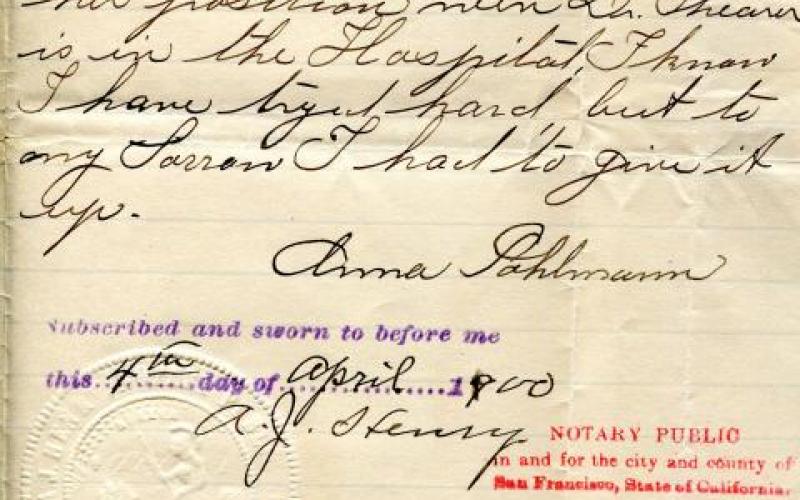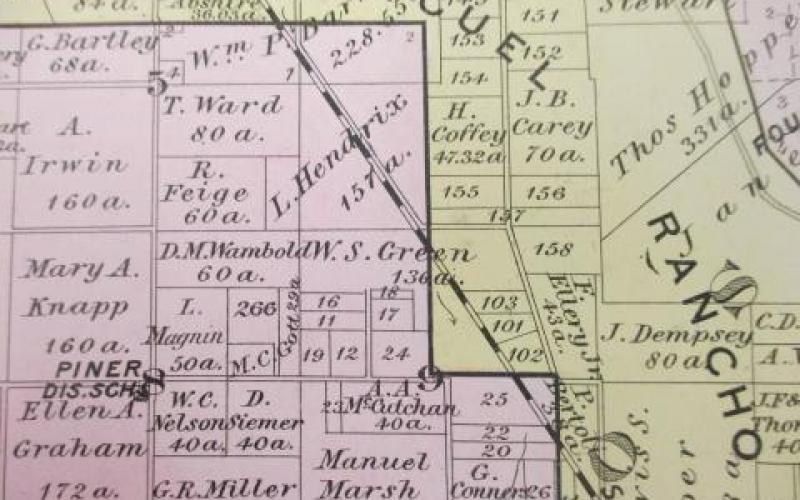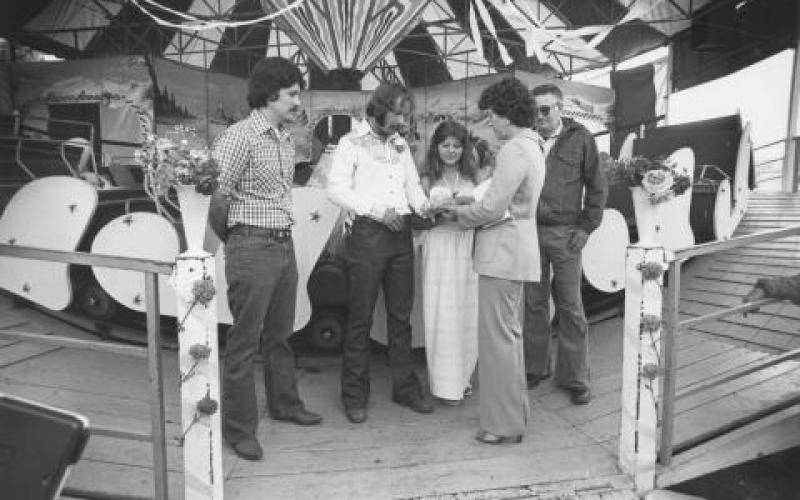Local History and Genealogy Notes
Their Time is Now
Posted on December 27, 2017
The recent cascade of public revelations by women who were sexually harassed or assaulted by popular societal figures whose behavior was allowed to continue unchecked for, in some cases, decades, bears a striking resemblance to a case that occurred in the spring of 1900 in Santa Rosa, the county seat of Sonoma. It is the case of a prominent doctor, Melville M. Shearer, who was in his fifth term as Sonoma County Physician when accusations were made against him by two of his subordinates, nurses of the Sonoma County Hospital.
The first nurse, 33-year-old Anna Pohlmann, worked as a matron at the county hospital from July 1899 to March 1900 and told her pastor of the treatment she received from Dr. Shearer, charging him with improper conduct toward her that had caused her to resign from her position. She further confided in the pastor that another nurse, Bertha Sundell, had also been compelled to resign for the same reason. The pastor then presented their complaints to the Santa Rosa Ministerial Union, an organization comprised of all the ministers of Santa Rosa. A committee was appointed to oversee the matter and told the nurses that their “unsupported statements amounted to but little and could not be recognized by [the union] unless they were put in the form of affidavits” (Statement by members of the Ministerial Union of Santa Rosa presented to the Sonoma County Board of Supervisors, 8 May 1900). The women obliged, and these handwritten affidavits, along with the statement by the Ministerial Union, were recently discovered by one of our volunteers who was sorting a box of miscellaneous Board of Supervisor records pulled from the Sonoma County Archives and brought to the Library.
A search of newspapers at the turn of the century reveals headlines such as “Scandal in a Hospital. The County Physician of Sonoma Accused by Nurses. Said to have paid them obnoxious attentions. Attendants declare that they were obliged to leave their positions” (SF Chronicle, 9 May 1900). Polhmann’s affidavit reveals her anguish: “Dr. Shearer has insulted me wenever [sic] he got a chance. If I had to buy anything for the Hospital, I always had to go to the Dr. Office for an order and he would invariable [sic] ask me to come up and spend the evening or even to stay all night with him in his office.” Sundell said it was her duty to tell of her experiences so that no other girl would be ruined:
He insisted on wanting to send out a buggy in the evening so I could come in and stay and spend the evening with him in his office. He several times during his visits at the Hospital sent out the other nurses in order to get a chance to insult me.
I liked it very much at the hospital but I could not put up with the Doctor any longer and the end would have been that he would have discharged me because I did not submit to his wishes and no woman with a pure character could keep the place but in order too would have to either be a corrupt woman or turn one.
On May 10, 1900, in the presence of the Board of Supervisors, members of the Ministerial Union, and a large crowd of interested citizens, Dr. Shearer flatly denied the charges against him. It is no surprise that his strategy to defend himself was to attack the character of Anna Pohlmann. One witness testified of her intemperance at work. Shearer claimed she sought revenge because he had discharged her from the hospital for intoxication. He also accused members of the Ministerial Union of personal bias against him. The final decision to exonerate the doctor of all charges was swiftly made with a vote of three “ayes” and one refusal. Supervisor Austin refused to vote because the Board had declined to postpone action in order to give Nurses Pohlmann and Sundell an opportunity to be heard in their own defense.
Dr. Shearer died five years later on 28 May 1905. He had served as a surgeon in the Union Army during the Civil War. In what was described as a moving eulogy at the Santa Rosa Lodge of Elks, Attorney Allison B. Ware paid tribute to “the deceased’s love of fellow man and his desire to assist the afflicted.”
Anna and Bertha disappear from the papers immediately following these events. Anna continued to work as a nurse after moving to Vallejo. They had had nothing to gain by speaking out but everything to lose. It must have taken immense courage to have gone public with their personal stories, shaming such a well-known and respected community leader, who had been repeatedly reelected by the very Board deciding the case. Because of their brave act, these women’s testimonies survive as part of the public record and have finally seen the light of day.
This is just one of the many personal stories hidden in the records of the Archives waiting to be discovered and illuminated…perhaps by you.
Coffey Park's Namesake by Mike Daniels
Posted on November 22, 2017
The Coffey Park area, so devastated by recent fires, was burned once before, in 1939. Then the area was rural—open fields, orchards, farmhouses, barns, and outbuildings. That ’39 fire, also spread by sudden winds, was the unfortunate result of a maintenance task gone wild at the old Santa Rosa Municipal Airfield that lay between Highway 101, Hopper Avenue, Piner Road and Coffey Lane.
Coffey Lane and its neighboring lands remained primarily rural until the early 1960s when Piner Road began to fill with a variety of businesses. Subdivisions of new homes soon followed and swallowed the fields and orchards westward to the Northwestern Pacific railroad tracks and beyond.
Threading through this northwestern section of Santa Rosa, Coffey Lane took its name from Henry Coffey, who with his family arrived in Santa Rosa from Mendocino County in 1885. The lane, its northernmost section today lopped off by the 101 freeway, once meandered from Steele Lane on the south through farms and such to take an easterly jog on the north to end at today’s Old Redwood Highway. That eastern section is today’s Alba Lane, opposite Cardinal Newman High School.
Henry Coffey took a wandering route to get here. Born in New York in 1832, his father died when Henry was very young. His mother packed up the family and moved to Michigan where she “took up government land” and began a farm.
When he was 18, Henry went to Indiana where he worked in a sawmill. There he married Nancy Gitchel. Soon, they returned to Michigan where their son, James H., was born. Within a year of their return, Nancy died. Two years later, Henry married Rebecca Davis. Their relationship lasted 52 years and produced an additional eight children: William M., Mary, Charles H., Joanna, Samuel A., Adeline, Minnie, and Octavia.
In 1862 the Coffey family moved overland to California. After farming in the Sacramento area, they traveled to Contra Costa and then Mendocino County always actively involved in agricultural and real estate pursuits.
Henry bought 320 acres in northwestern Santa Rosa, formerly known as the Sampson Wright place, in 1885. The land was quickly subdivided with each of the Coffey children being given 20 acres upon which they established their residence. The land was well suited for farming and was mainly planted with hay and grain, but there was also a sizeable orchard which produced prunes, apples, pears, peaches, and nectarines.The family vineyard consisted of table grapes of the Sweetwater, Muscat, and Rose of Peru variety.
Mr. Coffey’s industrious spirit included real estate. He bought and sold lots in the Farmer’s Addition and traded for property located in the old San Miguel Rancho.
Two of Henry and Rebecca’s daughters married Santa Rosans— Joanna aka Cynthia Josephine married into the Barnes family, developers of the first trading post outside of Sonoma (think Barnes Road), and Mary wed O.M. Tuttle, whose family would figure largely in Santa Rosa’s pharmaceutical trade.
By 1900 Henry was again on the move, this time leaving Santa Rosa for the East Bay. There, with Rebecca and daughter Octavia, he engaged in the real estate business. The family bought and sold properties in Oakland’s Brooklyn township, a lucrative geographical area between Lake Merritt and Oakland’s future bay side port.
Rebecca became ill not long after she and Henry celebrated their 50th anniversary in 1908. Daughter Minnie had earlier married Charles Smith, a minister and had moved to Orange in southern California. There Minnie cared for her ill mother who passed away in 1910.
Henry lived on in Oakland until his death in 1916. Seventy-two years later a Santa Rosa residential subdivision and neighborhood park constructed by Condiotti Enterprises would bear his name. Sadly a large number of these houses were lost to the 2017 Tubbs fire, but for those who wish to rebuild, many of the original architectural drawings for these residences are on file with Draftech Blueprinting, Inc., located at 1544 Terrace Way, Santa Rosa. Their phone number is (707) 578-9442.
Information for this article came from a variety of sources including An Illustrated History of Sonoma County published by the Lewis Publishing Company in 1889, which is available in book form at the Sonoma County History & Genealogy Library and online through the Internet Archive
Wednesdays are for Women - Thinking about Helen Putnam
Posted on October 04, 2017
It’s Wednesday and I’m thinking about women. In a week and a half I’ll be giving a talk at the Petaluma Regional Branch Library. The subject is the Ladies’ Improvement Club which was founded in 1896 by what a San Francisco Call reporter termed “Petaluma’s New Women” whose main objective was to improve and maintain two of Petaluma’s existing parks – or plazas as they were called at the time. The first officers of the club were Addie Atwater, president; Rena Shattuck, vice president; Kate C. Weston, secretary; Stella Newburgh, corresponding secretary; and Zoe Fairbanks, treasurer.
I’m enjoying researching the lives of these women and their colleagues; the times in which they lived and the larger City Beautiful Movement of which they were a part. As I prepare for my presentation I can’t help but think of another woman who was equally committed to the improvement of Petaluma and advocated for more parks and preservation of Petaluma’s rich historic and architectural heritage - Helen Putnam.
Helen DuMont Putnam (1909-1984) was elected as Petaluma’s first female mayor in 1965. She held this position until 1978. In 1979, she joined Helen Rudee as the second female member of the Sonoma County Board of Supervisors. There is much to be shared about Ms. Putnam’s accomplishments as an educator, mayor, and supervisor, but for the purposes of this post I’d like to highlight a walking tour she organized in May of 1975.
The walking tour coincided with Historic Preservation Week – something Mayor Putnam had codified by an official proclamation in which she called “on the people of the City of Petaluma and especially the preservation organizations, historical societies and other civic groups, to observe the week with activities and ceremonies designed to call attention to the urgent need to save our historic landmarks for the enjoyment and edification of our people present and future and to demonstrate our lasting respect for the unique heritage.” (Source: The Petaluma Argus-Courier, May 8, 1975).
The tour took place on May 18th. The tour began at the Petaluma Public Library on B and Fourth Streets. The tour goers were taken around the downtown with specific attention given to 11 buildings. Mayor Putnam was instrumental in planning the tour and served as hostess. The event was sponsored by the City of Petaluma, Heritage Homes of Petaluma, the Historic and Cultural Preservation Committee and the Petaluma Bicentennial Committee.
These days we can count on the volunteers associated with the Petaluma Museum to give tours of not only the downtown, but of the waterfront and various residential neighborhoods. Wouldn’t it be great if they could be joined by members of the City Council on occasion? Perhaps in May 2018. May is in fact National Historic Preservation Month.
From Church to Labor Temple
Posted on September 04, 2017
Back when the Petaluma Argus Courier was publishing the Petaluma Magazine I was lucky enough to contribute a regular feature called Changing Landscape where I'd provide a historic photo of a building, park, etc. with 500 words of background information. Terry Hankins, Argus photographer at the time, would take a current picture of the same site. I always planned to include this photo of the New Labor Temple. The Temple was located at the southeast corner of Western Avenue and Liberty Streets. The building was a remodel of the Methodist Episcopal Church South. Local builder, H.P. Vogensen, was responsible for the transformation from church to labor hall that occurred in the early 1920s. Ione "Sissy" Vogensen donated this photograph to the Sonoma County Library. Ione's husband was Richard Vogensen who was a grandson of H.P. Vogensen.
The building was torn down in the 1960s, and today the site is occupied by the Alphabet Soup Thrift Shop. For those who have been around for a bit, you'll remember this building as also being the former home of Plum Tuckered.
Marriage - Sonoma County Fair Style
Posted on August 11, 2017
I understand that today at the Sonoma County Fair it was Valentine's Day and that couples were invited to get married or renew their vows on Butler Amusements' Majestic Giant Wheel. In 2011, while researching in preparation for the Sonoma County Fair's 75th-anniversary museum exhibit, I came across this photo taken by Chris Dawson for the Press Democrat. Shown are Bill Albert and Wendy Entz getting married at the Fair in July 1980.
Instead of a ferris wheel, Bill and Wendy chose the Artic Flyer as their wedding "chapel." I checked Ancestry.com and found that their marriage is officially recorded in the California Marriage Index. William L. Albert, Jr. was 30, and Wendy D. Entz was 19 at the time.
According to the caption in a July 17, 1980, Press Democrat, Bill was a long time employee of Foley & Burke. For years Foley and Burke had the carnival contract at the Sonoma County Fair. The Artic Flyer was one of their rides. Wendy worked in a glass pitch booth. The Reverand Susan Bostick of Santa Rosa Psychic Institute officiated. Mike Smylie, Stockton, was best man. Fred Zertanna, a friend from the area, gave away the bride.






